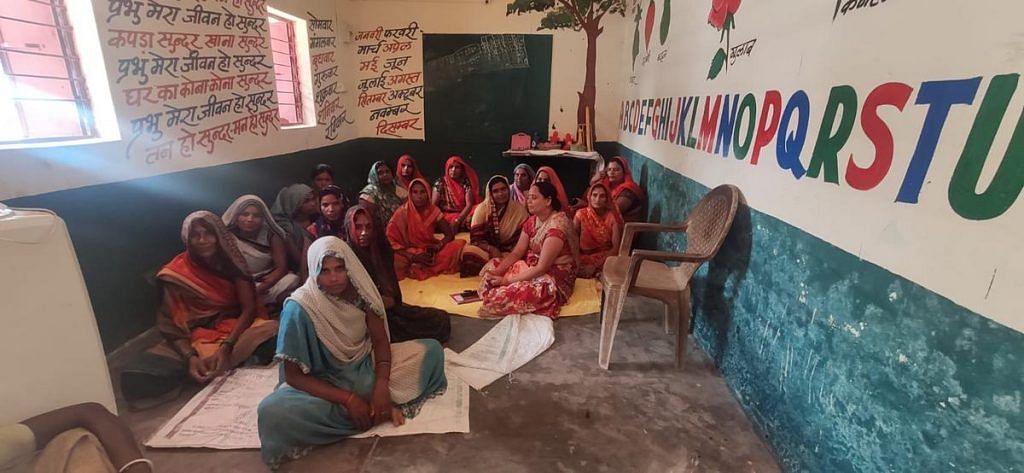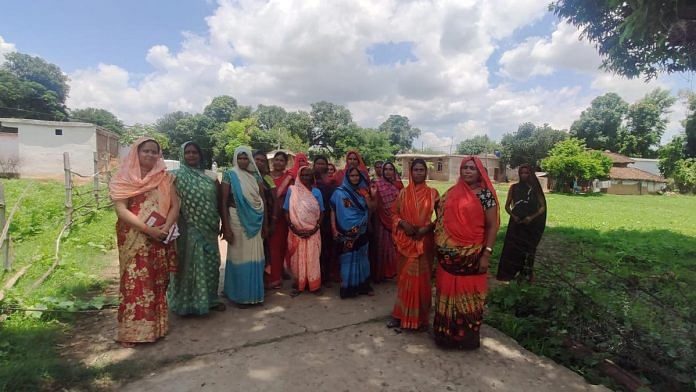Sonvarsha (Sidhi): Dressed in a bright red sari with a dupatta covering her head, anganwadi worker Praveen Singh is on a mission. She is rallying women to join the Ladli Behna Sena, which translates roughly as army of cherished sisters, as part of an ambitious scheme launched by the Madhya Pradesh government ahead of the upcoming assembly elections in November.
When The Print visited Sidhi district’s Sonvarsha village last week, Praveen was surveying the village’s 500 kacha and pucca houses, scattered amidst farmlands in the Vindhyachal foothills. As she went from house to house, Praveen sought out “outspoken and confident” women to become spokespersons for the scheme.
The Ladli Behna Yojana, launched by the state’s BJP government this March, promises Rs 1,000 per month to women between 23 to 60 years of age, with a total outlay of Rs 8,000 crore.
A crucial aspect of the scheme is the formation of the Ladli Behna Senas, networks of women volunteers working at the village and ward levels.
These groups, consisting of 15 or 21 women, include present beneficiaries of various government schemes and those working with Self Help Groups.
Monitored by dedicated anganwadi workers— like Praveen— their task is to ensure effective implementation of government welfare schemes and empower women by providing them a platform to voice their concerns.
However, some experts believe that the beneficiaries have another job too.
Professor Yatindra Sisosdia, director at MP Institute of Social Research in Ujjain told ThePrint that ‘Ladli Behna Sena’ is an attempt by the government to create a cadre at the village and ward level that act as their messengers.
“A member of the community talking about the benefits of a scheme will have a better impact than the same message being conveyed by a party worker,” he said. “But how effectively this sena will work on the ground remains to be seen.”
Speaking at a 10 July event to mark the release of the second installment of Rs 1,000 for beneficiaries, Chief Minister Shivraj Singh Chouhan underscored the importance of the Ladli Behna Senas.
“I’m alone, where all will I look? Will you not help me and assist me? We will all do it together. We are weak when we are alone but when we come together, we can face toughest situation… this is why I have created the Ladli Behna Sena,” he said.
There are over 2.60 crore women voters in MP, comprising about 48 per cent of MP’s 5.39-crore electorate, according to data from the State Election Commission.
So far, 1.26 beneficiaries have been registered under the Ladli Behna Yojana in Madhya Pradesh. Two installments of payments have been made as of July. The MP government transferred Rs 1,143 crore to the 1.26 crore beneficiaries in the first installment alone.
Earlier this month, notably, a supplementary budget of Rs 26,000 crore was passed in the state assembly to fund ongoing welfare schemes, merely four months after passing the state budget of Rs 3,14,025 crore for 2023-24.
Also Read: Madhya Pradesh BJP takes ‘panna’ from Gujarat book — ID cards for 38 lakh workers, page committees
Sonvarsha’s Ladli Sena
A group of women have gathered inside the brightly painted anganwadi centre in Sonvarsha. They are the chosen few.
As of 1 June, around 200 women received letters confirming them as beneficiaries of the Ladli Behna Yojana. Of these, 11 have been brought into the “sena” so far.
“We have enrolled over 200 eligible women in Ladli Behna Yojna, and this is our Ladli Behna Sena’,” says Praveen while pointing to the group of women seated on the anganwadi floor, their faces both curious and shy.

These women are part of a much larger network.
Across MP, more than eight lakh women have registered as part of the Ladli Behna Sena, divided into 53,000 such groups working at the village and ward levels.
In villages with populations below 1,500, like Sonvarsha, the Ladli Behna Sena comprises 15 women volunteers. Those with a population of above 1,500 have 21-member senas.
Praveen told ThePrint that two “training sessions” for implementing the scheme have been conducted in Sonvarsha. The first session was held for anganwadi workers, during which they were briefed about the scheme and tasked with forming the village Ladli Behna Sena. The second meeting involved these anganwadi workers briefing the selected members about their responsibilities.
‘We’d like to get work instead’
Fifty-eight-year-old Shyamvati Jaiswal and her daughters-in-law Ranjana and Annu are all members of Sonvarsha’s Ladli Behna Sena.
They have each received two installments under the scheme, but when asked if they are happy about this, Shyamvati’s response is tempered.
“What’s there to be happy about?” she asks. “Our requirement is for Rs 10,000, but we are getting Rs 1,000. Still, something is better than nothing, so why should we complain?”
Ranjana, on the other hand, appreciates the benefits. “The government provides houses under Awas Yojna, along with free ration and education. This money from Ladli Behna Yojna is an added bonus,” she says.
Annu is keen on spreading the benefits to others in the village. “We are getting the benefits and want others to get them too. We will guide them on the required documents and help them enroll,” she says.
However, for some, the monthly Rs 1,000 isn’t sufficient, considering the burden of inflation and unemployment.
“Look at inflation, the prices of tomatoes, oil, LPG cylinder. Considering all this, Rs 1,000 is nothing. We don’t’ even realise when we get the money and when it is gone. We would instead like to do some work through which we could get steady incomes to make ends meet,” says Rajkumari Yadav.
For many, the money goes towards paying for essentials, or even recharging their mobile phones. Savita Rajak, for example, used the first instalment of Rs 1,000 to buy an LPG cylinder in her house.Phool Kali Rajak, on the other hand, says she used money from the scheme to buy her blood pressure medication.
Speaking to ThePrint, RR Bhosle, commissioner of MP’swomen and child development department, said that the ultimate aim is to make beneficiaries more independent. According to him, the idea is that the beneficiaries will earn nearly Rs 10,000 over the next five years by working in self-help groups (SHGs) under the Aajeevika mission, a poverty alleviation and self-employment project under the central government’s Ministry of Rural Development.
But women in Sonvarsha claim that such opportunities are currently scarce.
Kalawati Rawat, raising her three sons and enrolled in a self-help group (SHG), says she is struggling find work.
“I joined the Yamuna SHG five months ago, but there’s been no work. We have to do something to make ends meet, so we work in the field earning Rs 200 a day,” she reveals.
Other women, meanwhile, are not entitled to benefits under the Ladli Behna Yojana because they are already enrolled under other schemes.
For instance, Neha Rajjak receives Rs 600 as a widow pension, so is ineligible. For her it is a daily battle to ensure the upkeep of her three children.
Similarly, Tara Jaiswal who also gets Rs 600 as handicapped pension is also ineligible to receive Ladli Behna benefits.
According to Praveen, the government is working on adding a provision to enable women under other schemes to also avail of benefits. But for women like Neha and Tara, this is no guarantee.
‘Jab tak mil raha hai, le lo’
While BJP leaders have been speaking of the Ladli Behna Yojana as a potential game-changer, some political analysts remain sceptical of its impact.
Prof Sisodia, for instance, described the scheme as yet another election-oriented “freebie”.
“The Ladli Behna Yojana is aimed at establishing a cliental relationship with the voters, who after receiving the benefit of the scheme would be inclined to give something in return,” he says.
He noted that the scheme targets rural women, a significant voting demographic, but even then it may only have a limited impact.
“After 18 years in power, the BJP government is facing fatigue and anti-incumbency. This scheme can’t be seen as a game changer,” he adds.
Some beneficiaries, too, take a cynical view, such as Kalawati Rawat.
“Everybody understands that the government announced the scheme because elections are around the corner,” she says. “Jab tak mil raha hai, le lo. Jab band ho jaega, tab baith jaenge (Take it while you get it. When it stops, we’ll see).”
(Edited by Asavari Singh)
Also Read: ‘Spitting’ row: Muslim family’s building demolished amid DJ music, drum beats in Ujjain



